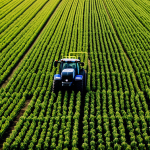Essential Perennial Vegetables for UK Gardens
When selecting perennial vegetables for UK gardens, understanding which varieties thrive in local climates is crucial. The UK’s temperate conditions favour hardy, resilient crops that can withstand cool winters and variable rainfall. Some of the best perennial crops suited to these conditions include asparagus, rhubarb, and globe artichoke. These vegetables return year after year, offering sustainable yields with less replanting effort.
Beyond the common choices, there are several lesser-known edible perennials worth exploring, particularly by experienced gardeners looking to diversify. Good examples include skirret, which produces sweet, carrot-like roots; perpetual spinach, a leafy green that continually regenerates; and Good King Henry, a traditional green now enjoying resurgence for its drought tolerance and versatility in cooking.
Also read : Mastering greenfly biocontrol: top strategies for uk greenhouse success
Choosing the right perennial vegetables UK gardeners should focus on involves considering factors such as soil type, exposure, and regional climate. Plants that demand well-drained soils and full sun are generally more productive but may require extra soil preparation. Conversely, varieties like sorrel and alpine strawberries can tolerate shadier, less fertile spots and still provide good yields.
Understanding these points allows gardeners to tailor their plant selections effectively. Emphasising both the popular staples and exploring lesser-known edible perennials offers a balanced, productive, and year-round edible garden that thrives in UK conditions.
This might interest you : Thriving with lavender in the uk: expert tips for lush growth and abundant yields
Advanced Soil Preparation and Site Optimisation
Fine-tuning soil preparation for perennials is essential to maximise the potential of perennial vegetables UK gardeners choose to grow. Unlike annuals, perennials remain in the ground for multiple years, so the soil must be fertile, well-structured, and balanced to support sustained root growth and nutrient uptake.
To enhance soil fertility, start by testing soil pH and nutrient levels. Most best perennial crops thrive in slightly acidic to neutral soils (pH 6.0-7.0). Incorporating organic amendments such as well-rotted compost or aged manure improves soil texture and releases nutrients slowly, which benefits long-term health. Mulches—like leaf mold or straw—help maintain moisture levels, regulate temperature, and suppress weeds without disturbing the delicate root zones of perennials.
When considering site selection techniques, microclimate variation plays a crucial role. Choose locations protected from strong winds and with adequate sunlight tailored to specific perennial needs. For example, sun-loving crops like asparagus require full exposure, whereas shadier spots are suitable for lesser-known edible perennials like Good King Henry. Slight elevation or gentle slopes improve drainage, preventing root rot, a common issue in heavy UK soils.
Advanced gardening UK practices recommend integrating raised beds or mounded rows for water management and soil warming. Creating diversity in site layout also supports resilience against extreme weather. Combining these approaches allows gardeners to optimise conditions for long-term productivity and plant vitality, translating directly into more abundant yields from perennial vegetables UK gardeners rely on.
Essential Perennial Vegetables for UK Gardens
Selecting the best perennial crops for UK gardens involves prioritising plants that reliably withstand the country’s temperate climate while delivering productive yields over multiple seasons. Among the most resilient perennial vegetables UK gardeners favour are asparagus and rhubarb, both known for their ability to establish deep root systems that survive frost and fluctuating rainfall. These staples provide a foundation for any sustainable garden aiming to reduce yearly planting effort.
For gardeners seeking to expand beyond traditional choices, exploring lesser-known edible perennials offers exciting opportunities. Crops such as skirret and Good King Henry flourish with minimal intervention and can adapt well to UK soils. Skirret, for instance, produces sweet, white roots reminiscent of carrots but with greater cold tolerance. Good King Henry is valued for its dual use as a leafy green and a green bean substitute, showcasing versatility. Including such plants can diversify yields and impart novelty to the garden.
Choosing appropriate perennial vegetables UK gardeners should also factor in specific site conditions. Plants demanding full sun and well-drained soils, like asparagus, often yield best on raised beds or slopes that prevent waterlogging. Conversely, species such as sorrel or perpetual spinach succeed in partial shade and heavier soils, broadening planting options even in less ideal spots. Matching plant needs to garden microclimates thus maximises health and productivity.
In summary, a robust UK garden mixes proven best perennial crops with intriguing, underutilised species. Careful selection guided by climate resilience and site suitability helps gardeners establish a diverse, lasting edible landscape that thrives year after year.
Essential Perennial Vegetables for UK Gardens
Selecting perennial vegetables UK gardeners can rely on requires understanding the resilience and productivity necessary for the British climate. The best perennial crops thrive despite cool winters and variable moisture, offering repeated harvests with minimal annual replanting. These crops develop deep root systems that resist frost and efficiently tap into soil nutrients, crucial traits for sustainable growth.
Among well-established options, asparagus and rhubarb remain top performers, but incorporating lesser-known edible perennials can broaden both yield variety and garden resilience. For example, skirret produces sweet, edible roots that withstand cold snaps better than many root crops. Similarly, Good King Henry provides dual-use foliage and shoots, making it a versatile addition. These underused perennials can thrive alongside staples, especially when paired according to their specific site needs.
Choosing plants that suit given garden conditions enhances success with perennial vegetables UK gardeners must evaluate sunlight exposure, drainage, and soil texture carefully. Plants demanding full sun and well-drained soils, such as globe artichoke or asparagus, benefit from raised beds or slopes. Conversely, those like sorrel and perpetual spinach tolerate partial shade and heavier soils, expanding options for less ideal locations. This tailored approach to selection ensures both optimal growth and longevity.
In essence, integrating both proven best perennial crops and lesser-known edible perennials allows for a balanced, productive garden. This strategy embraces diversity and climate adaptability, which are key to establishing a thriving perennial vegetable patch in UK gardens.
Essential Perennial Vegetables for UK Gardens
Selecting the right perennial vegetables UK gardeners can depend on involves focusing on plants with proven resilience and productivity under British climatic conditions. The best perennial crops consistently endure cool winters and irregular rainfall, developing robust root systems that tap deep soil nutrients season after season. This resilience reduces the need for frequent replanting and maximises sustainable harvests.
For gardeners interested in variety beyond the classics, several lesser-known edible perennials deserve attention. These crops offer unique flavours and textures while adapting well to UK environments. For example, skirret produces sweet, carrot-like roots with excellent cold tolerance. Good King Henry supplies both leafy greens and edible shoots, adding versatility to the kitchen. Such underused perennials thrive with minimal maintenance, making them valuable additions to diversify yields and improve garden resilience.
Choosing the best perennial vegetables UK growers must also be guided by site-specific factors: sunlight availability, soil drainage, and texture. Full sun and well-drained soils benefit crops like asparagus and globe artichoke, often supported by raised bed planting to prevent waterlogging. In contrast, shade-tolerant plants such as sorrel and perpetual spinach flourish in heavier soils or partially shaded areas, broadening options across diverse garden settings. Careful matching of plant needs to microclimates ensures higher longevity and productivity.
Ultimately, blending established best perennial crops with creative use of lesser-known edible perennials creates a robust, sustainable garden. This approach harnesses the unique strengths of each plant, fostering year-round productivity tailored to UK growing conditions.
Essential Perennial Vegetables for UK Gardens
Choosing the right perennial vegetables UK gardeners depend on means focusing on durability and consistent yield under British climatic conditions. The best perennial crops are those that adapt well to fluctuating temperatures and rainfall, ensuring repeated harvests without needing annual replanting. They typically develop deep root systems that enhance stability and nutrient uptake, traits vital for thriving in temperate UK soils.
While classic choices such as asparagus and rhubarb are widely known for their reliability, exploring lesser-known edible perennials offers gardeners the opportunity to diversify and enrich their gardens. For instance, skirret, with its sweet, clustered roots, tolerates cold better than many root crops and provides a unique harvesting experience. Similarly, Good King Henry serves dual purposes through edible shoots and leaves, adding both culinary versatility and resilience.
When selecting these plants, consideration of site conditions becomes paramount. The best perennial crops often require full sun and well-drained soils; raised beds or gentle slopes help prevent waterlogging common in UK gardens. Conversely, some lesser-known edible perennials, like perpetual spinach and sorrel, can tolerate partial shade and heavier soils, increasing the planting options available even in shaded or less fertile plots.
By balancing the integration of well-established perennials with underused varieties, gardeners create diverse, productive gardens that maintain vitality throughout years. This strategic selection respects UK growing challenges while leveraging the strengths of a broad range of perennial vegetables UK enthusiasts can successfully cultivate.
Essential Perennial Vegetables for UK Gardens
Selecting perennial vegetables UK gardeners can truly depend on requires a fine balance of resilience, productivity, and adaptability to the British climate. The best perennial crops excel by developing vigorous root systems that endure cool winters, irregular rainfall, and fluctuating temperatures typical across the UK. These robust traits reduce the need for frequent replanting, ensuring sustained harvests year after year.
Beyond the well-established staples, incorporating lesser-known edible perennials expands both the diversity and resilience of the garden ecosystem. Examples include skirret, prized for its sweet, clustered roots that tolerate frost better than many root crops, and Good King Henry, which offers dual culinary uses with edible shoots and leaves. Such plants often require less intervention and adapt well to varying soil conditions, increasing overall garden productivity.
Choosing the right perennial vegetables UK gardeners should consider several critical factors beyond simple hardiness. Sunlight exposure is paramount—crops like asparagus and globe artichoke demand full sun and well-drained soils frequently found on raised beds or slopes to prevent waterlogging. On the other hand, lesser-known edible perennials like sorrel and perpetual spinach flourish in partial shade and heavier, moisture-retentive soils, broadening options for gardens with suboptimal conditions. Matching plant requirements to specific microclimates optimises growth longevity and yield.
In summary, a successful perennial vegetable plot in the UK blends the most dependable best perennial crops with intriguing, underutilised species. This selection strategy leverages climatic adaptability and culinary versatility, resulting in a productive, sustainable garden that flowers season after season.






